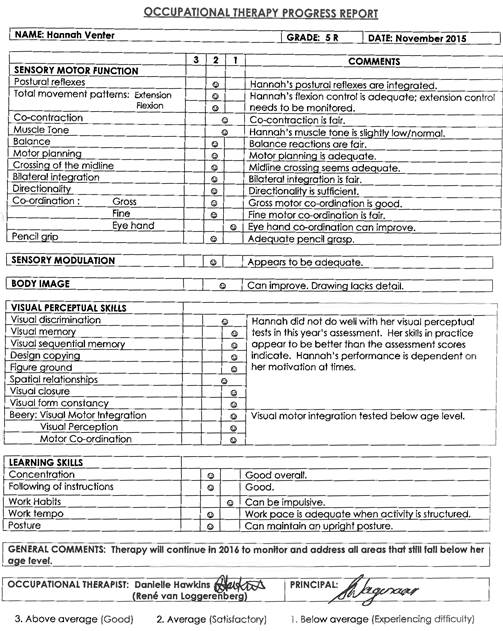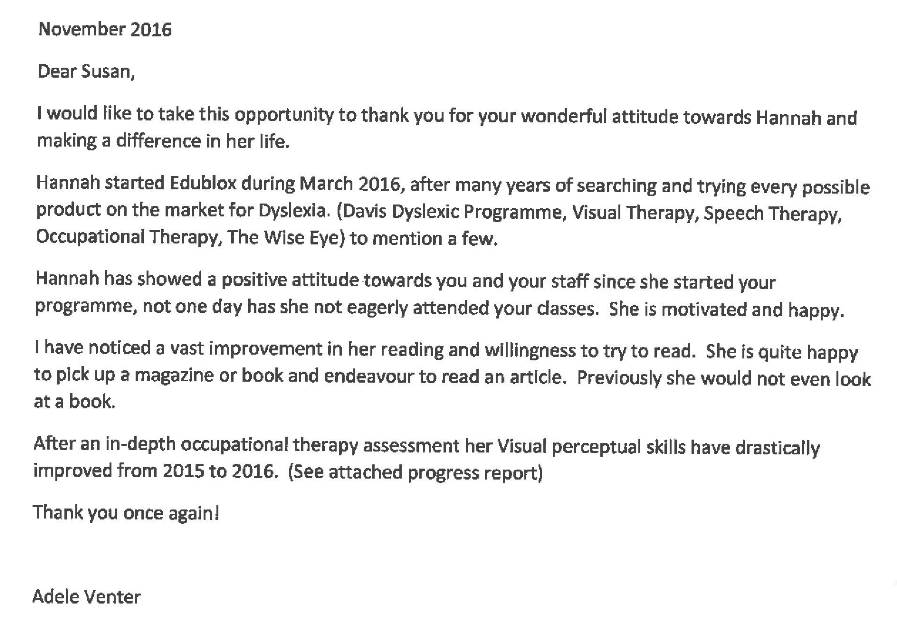
Hannah was diagnosed with severe dyslexia. Follow her progress after starting Edublox, as witnessed by an occupational therapist, her mom, and a remedial practitioner. She has made “excellent and pleasing improvement in areas of sensory motor function as well as visual perception” and “remarkable progress in terms of her academic and emotional development.”
Diagnosed with severe dyslexia
Young Hannah entered a remedial school in 1st grade and started attending their weekly occupational therapy, speech therapy, and remedial therapy sessions. Before long, she was diagnosed with severe dyslexia.
While there are other causes, research has shown that deficits in visual perception may cause or contribute to dyslexia. This was the case with Hannah.
What is visual perception?
Visual perception refers to the ability to make sense of information taken in through the eyes. Difficulties with visual perception differ from problems involving sight or sharpness of vision, as they affect how visual information is interpreted or processed. A child with visual perceptual problems may have 20/20 vision but may have perceptual difficulties.
Visual memory is often considered a subset of visual perception rather than a separate skill. Visual memory involves storing and retrieving previously experienced visual sensations and perceptions when the stimuli that originally evoked them are no longer present. That is, the person must be capable of making a vivid visual image in his mind of the stimulus, such as a word, and once that stimulus is removed, be able to visualize or recall this image without help.
Little improvement after years of treatment
Despite all the help afforded at her remedial school and notwithstanding trialing many other products and programs, Hannah’s visual perceptual skills were still “below average” by the end of her 5th-grade year. See Hannah’s occupational therapy progress report, dated November 2015, below.
Scale:
3 = Above average (Good)
2 = Average (Satisfactory)
1 = Below average (Experiencing difficulty)

“Excellent improvement” after Edublox enrolment
Hannah’s mom enrolled her at Edublox in March 2016. Edublox aims to address the underlying shortcomings that interfere with academic performance. Underlying shortcomings include visual perception.
The assessment below is Hannah’s occupational therapy progress report dated November 2016, nine months after starting at Edublox. She has made “excellent and pleasing improvement in areas of sensory motor function as well as visual perception.”

Visual memory: Improved from 1 to 3. “Excellent improvement. Well above standard.”
Visual sequential memory: Still a 1. “Excellent improvement, but still below standard.”
Design copying: Improved from 1 to 3. “Excellent improvement. Above standard.”
Figure-ground: Improved from 1 to 3. “Excellent improvement. Above standard.”
Spatial relationships: Improved from 1/2 to 3. “Excellent improvement. Well above standard.”
Visual closure: Improved from 1 to 2. “Very good improvement. Now on standard.”
Visual form constancy: Still a 1. “Very good improvement. Just below standard.”
Beery Test: Visual-motor integration: Improved from 1 to 2. “Good ability. On standard.”
Beery Test: Visual perception: Improved from 1 to 3. “Excellent improvement. Above standard.”
Beery Test: Motor coordination: Improved from 1 to 3. “Excellent improvement. Above standard.”
Hannah’s mom wrote

“Remarkable progress,” according to a remedial practitioner
Below is Hannah’s progress, as evaluated by Dr. Lombard, an educational and remedial practitioner, who has assessed Hannah biennially since 2011.
Dr. Lombard used several tests to assess Hannah’s progress, including:
- HSRC graded test for skills development
- Bender-Gestalt
- Laterality
- Receptive language
- Reading, comprehension, and spelling
HSRC graded test for skills development
This test consists of six subtests. Scoring 0-3 for a subtest is considered to be “below average,” 4-6 “average,” and 7-10 “high average.” After joining Edublox, Hannah scored “high average” for every subtest.
Test 1
This test assesses the learner’s ability toward VISUAL DISCRIMINATION. Below are Hannah’s scores:
03/18/2011: 1.5 (below average)
05/03/2013: 6.9 (average)
07/08/2015: 4.7 (average)
05/07/2017: 8.4 (high average).
Test 2
This test assesses the learner’s ability toward FINE AND EYE HAND COORDINATION, concentration, laterality, distinguishing of foreground/background, persistence and perseverance. Below are Hannah’s scores:
03/18/2011: 3 (below average)
05/03/2013: 4 (average)
07/08/2015: 4 (average)
05/07/2017: 8 (high average).
Test 3
This test assesses the learner’s ability toward VERBAL REASONING, concentration, abstract thinking, and cultural/pedagogical background. Below are Hannah’s scores:
03/18/2011: 5 (average)
05/03/2013: 8.3 (high average)
07/08/2015: 8.3 (high average)
05/07/2017: 8.3 (high average).
Test 4
This test assesses the learner’s ability toward ABSTRACT THINKING, visual discrimination, concentration, reasoning and cultural/pedagogical background. Below are Hannah’s scores:
03/18/2011: 6 (average)
05/03/2013: 6 (average)
07/08/2015: 10 (high average)
05/07/2017: 10 (high average).
Test 5
This test assesses the learner’s ability toward NUMBER CONCEPTS, concentration, visual discrimination, and cultural/pedagogical background. Below are Hannah’s scores:
03/18/2011: 0 (below average)
05/03/2013: 2 (below average)
07/08/2015: 6 (average)
05/07/2017: 8.3 (high average).
Test 6
This test assesses the learner’s ability toward Gestalt (shape concepts), ANALYSIS/SYNTHESIS, laterality, position in space, concentration, and fine motor coordination. Below are Hannah’s scores:
03/18/2011: 3 (below average)
05/03/2013: 6 (average)
07/08/2015: 6 (average)
05/07/2017: 8 (high average).
Bender-Gestalt
This test consists of nine elementary figures that the learner has to copy. The protocol is scored in terms of mistakes made, for example, rounding an angle or making a circle instead of a dot. The score indicates the visual-motor maturity of a person.
Since joining Edublox, Hannah’s score has improved from “on standard” to “above standard”:
07/08/2015: “Hannah copied the figures and achieved a score that is on standard for her expected age level.”
05/07/2017: “Hannah copied the figures and achieved a score that is above standard for her expected age level.”
Laterality
Laterality entails the establishment of a dominant side of the brain – i.e., the grade of superiority of one side of the body above the other side related to sensory input as well as motor ability.
Since joining Edublox, Hannah’s midline crossing has improved:
07/08/2015: “She still could not cross her midline sufficiently. Her knowledge of lefts and rights is adequate.”
05/07/2017: “Midline crossing has improved, as well as knowledge of lefts and rights.”
Receptive language
Receptive language is the learner’s ability to comprehend or understand language. Hannah was required to listen to sentences varying in length and complexity.
Since joining Edublox, Hannah’s ability to understand complex grammatical concepts has improved from “under average” to “average”:
07/08/2015:
- “Elaborated sentences: average
- “Grammatical morphemes: average
- “Complex grammatical concepts: under average.”
05/07/2017:
- “Elaborated sentences: average
- “Grammatical morphemes: average
- “Complex grammatical concepts: average.”
Improvement in reading, comprehension, and spelling
Hannah’s reading was 3 years and 6 months below her chronological age in 2015. Since joining Edublox in March 2016, this deficit has decreased to only 2 years. In addition, she scored 80% for comprehension:
07/08/2015: “Performance yielded an age equivalence that is 3 years and 6 months below chronological age, which explains her low scores for accuracy and comprehension. Her spelling tested on Grade 2 [term 2].”
05/07/2017: “Her performance in 2017 yielded an age equivalence that is only 2 years below chronological age. She, furthermore, got an average of 80% for comprehension. Her spelling tested on Grade 4 [term 1].”
Dr. Lombard concluded
05/07/2017: “HANNAH HAS MADE REMARKABLE PROGRESS IN THE PAST FEW MONTHS – in terms of her academic and emotional development.”
Edublox offers cognitive training and live online tutoring to students with dyslexia, dysgraphia, dyscalculia, and other learning disabilities. Our students are in the United States, Canada, Australia, and elsewhere. Book a free consultation to discuss your child’s learning needs.

